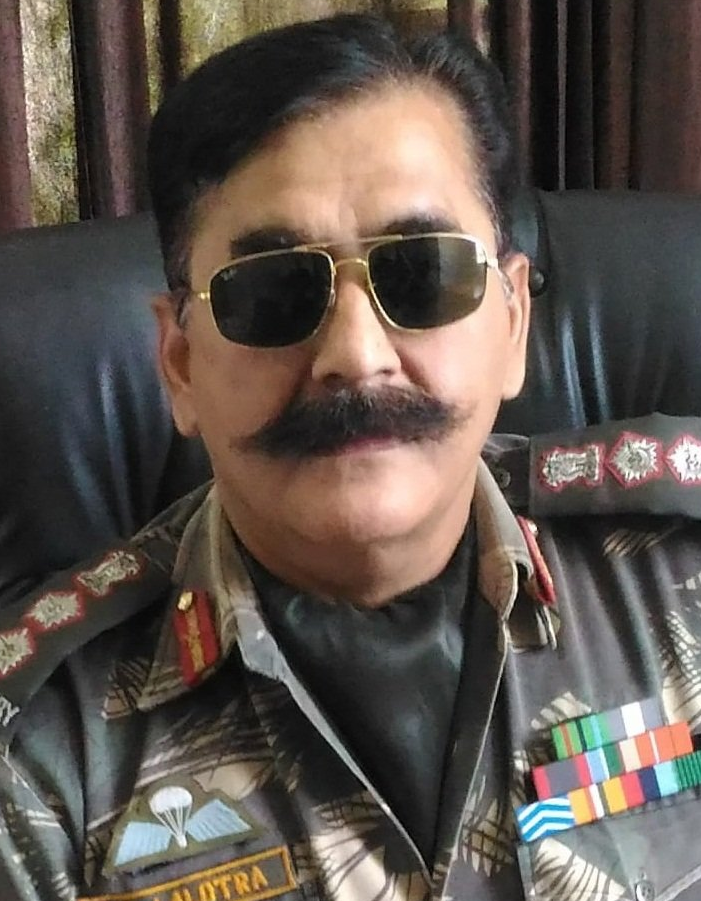Are Cosmetics Defining India’s ‘Vibrant Village Programme’?
“It takes a few to make war, but it takes a village and a nation to build peace….”Abiy Ahmed

By Colonel Satish Singh Lalotra
Since the time NDA government under the watchful gaze of its Prime Minister been at the helm of the affairs of this great sub-continent, no occasion be at the national or international stage been bereft of Chinese machinations. It seems as if the game of ‘Chinese checkers’ is being played very deftly by the PRC ( People’s republic of China) to race all its pieces into the star corner on the opposite side of the board before the opponent ( India) does the same. The pieces that China has been willing to race and is still counting its chickens (result) before they come home to roost, range from an extensive border area development to include laying of extensive rail/ road network, improved signal communication grid, building of few airports as also rolling it’s so called ‘Civil-military fusion’ doctrine that lays emphasis on border area villages and making common cause of their local aspirations with that of national aspirations.
This way the Chinese contemplate to completely dominate the LAC and its inhabitants living in their part of land thereby making ‘boots on ground’ of PLA a bit less visible in all their manifestations. A perfect ruse for the world to fall into. Though India has had the chance to checkout this Chinese Chicanery in 1962 at the cost of monumental national ignominy which still gnaws its very vitals, it has nevertheless put the pain rapped on its knuckles past it’s conscious by the yellow race by going on the double on its buildup of physical infrastructure and its attendant issues all along the LAC.
To counter this so called ‘Civil-military fusion’ technique of PRC, India too since 2023 has upped the ante by introducing its flag ship programme , the VVP –Vibrant village programme that was flagged off from the remotest corners of the country last year in February 2023. With a mega-project worth Rs 4,800 crores earmarked for the developmental activities in the border villages starting from Arunachal Pradesh till UT of Ladakh. It primarily envisages countering aggressive Chinese infrastructure expansion tactics, particularly the so called ‘Military villages’ close to the LAC. These villages spanning regions like Himachal Pradesh, Sikkim, Arunachal Pradesh, Uttrakhand & Ladakh are integral to the India’s border security and management that lie in many places in shambles due to inadequate infrastructure, leading to socio-economic disparities and ultimately to mass migration and consequently earning the ill-fated sobriquet of ‘Ghost villages’.
With the various military standoffs that India has had in the recent years with its northern neighbor, the overall sustenance that had been coming their way to the PLA were traced back to these military villages which acted as ‘firm bases’ for them to reel on to the LAC and fall back too. With this at the center of its planning to counter Chinese perfidy, India has embarked on an ambitious project as explained above to upgrade 662 villages within a 10 km radius of the border. At a seminar organized by the DRDO (Defense Research and Development Organization) in Delhi in the month of May this year, defense secretary Mr Giridhar Armane reiterated government’s stand and commitment to upgrade border infrastructure to match up the fast skewed infra between the two Asian giants across the LAC.
But if the reports and news snippets emanating from the interiors of such border states are to be believed then even today the chasm between the aspirational levels desired and existing of the locals of these states persist which is difficult to bridge ‘Vibrant Village Programme’ notwithstanding. Some of the impediments that are existing since ages affecting the vibrancy of such an important national project are :
- Lack of will on the part of local officials and administrative units at block and higher levels to bond and take the essence of developmental activities to the people.
- Identification of true needs and aspirations of the locals by the local administrative bodies.
- No up gradation of roads, medical and health and communications facilities since decades.
- A very lackadaisical approach by the local MLA’s to take a routine uptake of their area’s needs and conjoining them with the flag ship programme so initiated by the central government.
- No effective follow up in the form of ATR (Action taken reports) by those in the higher chain of command as to the implementation of these activities.
- A lack of concerted drive to ascertain the core areas of concern of the locals , which stems from non-participatory attitude of the locals too ; a byproduct of years of neglect and indifference from the mainstream governance.
In the border villages of Arunachal mainly populated by the tribes of Monpa, Nyishi and such like that live strung from Tawang , Zemithang, Laching Bagang in the Chayang Tajo sub division it seems as if time has stood still with people too having accepted the fait accompli of their sub-human existence. These distant villages are still about 4 to 5 days of walking distance or ride on ponies from each other. Lack of cell towers leading to a near blackout of information hasn’t helped much either in bonding these border people with rest of India. With Chinese communication network quite strong aided by a favourable topography unlike across the Mac Mohan line on the Indian side , the locals of the area are constantly bombarded by a plethora of programmes that further instill a sense of alienation in the people vis a vis India.
This sense of alienation was further aggravated last year with China releasing standardized geographical names in ‘Zangan’ (Chinese name for southern Tibet / Arunachal Pradesh) including ‘Zemithang’ in their own language. The near absence by the Indian government to rebut these Chinese perfidies last year further added to many misgivings in the minds of these hapless locals. The fact that it took nearly more than a year for India to reply China in its own language this June by officially announcing to rename more than thirty places In Tibet by Indian names shows a big vacuum in the Indian government’s promptness to stymie Chinese attempts towards internal interference in neighboring countries.
This is where the joining of efforts in terms of government’s schemes i.e VVP (Vibrant Village Programme ) and rebuttal by the MEA ( Ministry of external affairs) towards Chinese perfidy will yield positive results. In fact India could take a leaf out of Chinese joining hands of their ‘Ministry of Civil affairs’ which was spearheading their attempts to rename many places in Arunachal Pradesh with Chinese names with that of state council which is the central cabinet of China. The above shows that India has been lagging far behind in getting all its departments out of the silos to take on the Chinese covert attempts of undermining its sovereignty.
Readers of this write up will do well to take their minds back that this latest attempt by the Modi government in kick starting VVP programme is reflective of decades of inertia of past dispensations in building up requisite infra in the border areas of the country. In particular the famed ‘Maj Gen Himmat singhjhi committee’ on border area infrastructure formed in early 1950s on explicit directions of the first PM Nehru didn’t gather traction that it should have, is now rearing its head in the form of belated attempts to plug these loop holes by way of VVPs and also the so called ‘Gatishakti’ programme a national master plan for multi modal connectivity. Essentially a digital platform to bring 16 ministries including the railways and roadways together for integrated planning and coordinated implementation of infrastructure connectivity projects.
It is not that concerted efforts have not been undertaken in the last one and half years since the time VVP was launched by the Home Minister Mr Amit Shah from the easternmost town of the country –‘Walong’ signifying the nation’s resolve in integrating its fringe areas into the mainstream of governance. A commendable effort in upgrading ‘border area tourism’ has been underway from Ladakh till Arunachal Pradesh taking the concept of showcasing the intrinsic value systems that have the signatures of its people, culture and religiosity so ingrained in them. Buddhism being the mainstay of religious importance of the border area people of these regions, it is but natural that Lord Buddha and his teachings finds its manifestations in myriad ways only to be showcased to an eager visitor.
One such recent effort towards this end has been the installation of statues of Lord Buddha at two LAC Hotspots–Lukung and Chushul. The installation very deftly combines the developmental efforts under the VVP pogramme as well as giving a heft to the psychological operations (Psy ops) undertaken by the IA. The statues show Buddha in typical ‘Bhumisparsha Mudra’. Two more similar statues are being planned at Demchok and nearby areas. The locations of these two statues is important since Lukung is on the NW edge of Pagong Tso, while the statue at Chushul faces the famous ‘Spanggur gap’, the border meeting point of two armies of India and China. The Chinese garrison of Moldo is around 8 kms from there. There are many more sub-programmes under the aegis of VVP which when launched with a ‘Mission- mode’ thinking could reverse years of neglect of border areas of India.
Taking the concept in the far eastern corner of India,the Arunachal Pradesh government is developing the so called ‘Escape trail’ of the Tibetan spiritual leader HH Dalai Lama from where he entered India into ‘Spiritual and tourism circuit’. Little known ‘Lumla’ in western Arunachal Pradesh’s Tawang district would be soon on the national tourism map. The young Dalai Lama had passed through and also stayed in this area in 1959 during his escape from Lhasa to India. In addition to this five monoliths are being constructed in each place where Dalai Lama spent the night during his journey to India from Tibet. As if these were not enough, a small gate known as ‘Lhasa Dwar’ the point where Dalai Lama entered India, is marked by the holy tree which is supposed to have grown from a staff dug by his holiness himself.
It is now being worshipped as a relic marking the historic event. Be that as it may, since the onset of this highly commendable VVP programme has been launched an air of expediency has been doing rounds in these border states of the country which hitherto was not even on the thinking radars of our national planners for whom North eastern area started and finished with in the sighting distance of river Brahmaputra at Guwahati. Border areas of the country should have that allurement in themselves to help keep their younger lot attached to their homes and hearths by way of providing alternative means of livelihoods, development at a scale that out paces their aspirations, a safe and secure ecosystem for their overall growth and development and last but not the least act as ‘Eyes and ears’ for the government of the day to quickly take action if forces inimical to India’s interest try fishing in troubled waters.
(The writer is a regular scribe of RK and can be approached on his email: slalotra4729@gmail.com)



